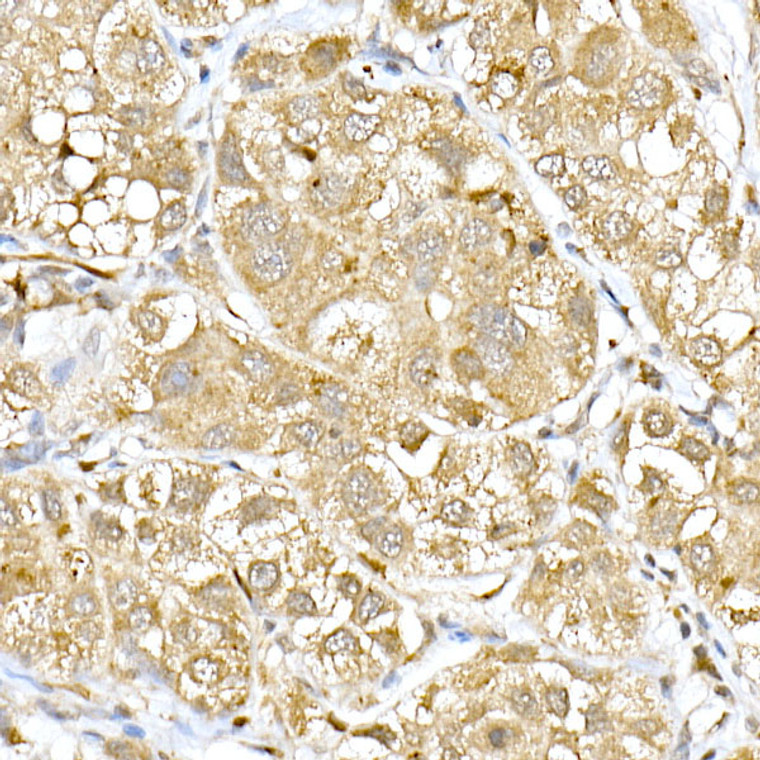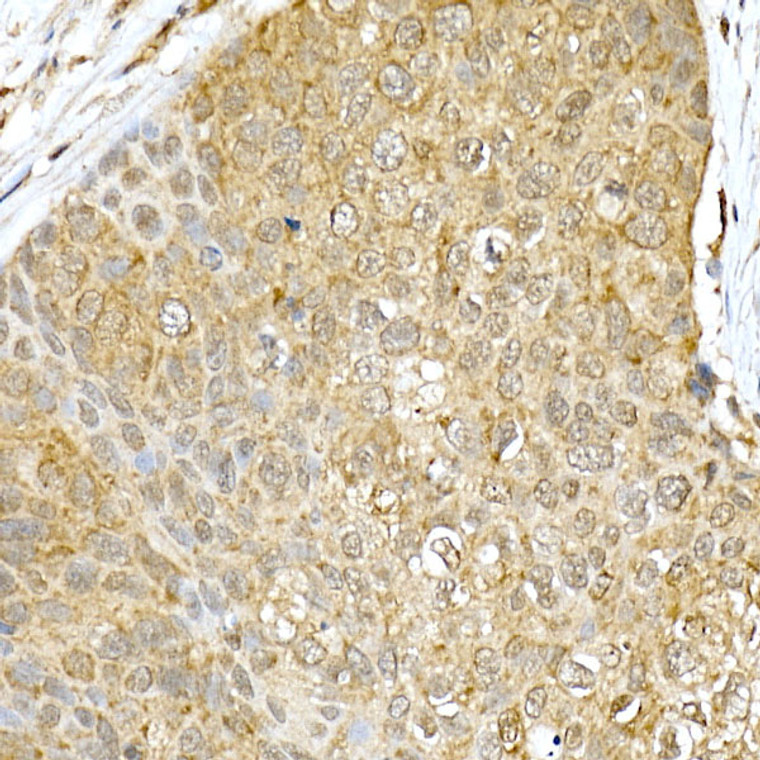| Host: |
Rabbit |
| Applications: |
WB/IHC |
| Reactivity: |
Human/Mouse/Rat |
| Note: |
STRICTLY FOR FURTHER SCIENTIFIC RESEARCH USE ONLY (RUO). MUST NOT TO BE USED IN DIAGNOSTIC OR THERAPEUTIC APPLICATIONS. |
| Short Description: |
Rabbit polyclonal antibody anti-Dna Damage-Inducible Transcript 3 Protein (1-80) is suitable for use in Western Blot and Immunohistochemistry research applications. |
| Clonality: |
Polyclonal |
| Conjugation: |
Unconjugated |
| Isotype: |
IgG |
| Formulation: |
PBS with 0.05% Proclin300, 50% Glycerol, pH7.3. |
| Purification: |
Affinity purification |
| Dilution Range: |
WB 1:500-1:1000IHC-P 1:50-1:200 |
| Storage Instruction: |
Store at-20°C for up to 1 year from the date of receipt, and avoid repeat freeze-thaw cycles. |
| Gene Symbol: |
DDIT3 |
| Gene ID: |
1649 |
| Uniprot ID: |
DDIT3_HUMAN |
| Immunogen Region: |
1-80 |
| Immunogen: |
Recombinant fusion protein containing a sequence corresponding to amino acids 1-80 of human DDIT3/CHOP (NP_004074.2). |
| Immunogen Sequence: |
MAAESLPFSFGTLSSWELEA WYEDLQEVLSSDENGGTYVS PPGNEEEESKIFTTLDPASL AWLTEEEPEPAEVTSTSQSP |
| Post Translational Modifications | Ubiquitinated, leading to its degradation by the proteasome. Phosphorylation at serine residues by MAPK14 enhances its transcriptional activation activity while phosphorylation at serine residues by CK2 inhibits its transcriptional activation activity. |
| Function | Multifunctional transcription factor in endoplasmic reticulum (ER) stress response. Plays an essential role in the response to a wide variety of cell stresses and induces cell cycle arrest and apoptosis in response to ER stress. Plays a dual role both as an inhibitor of CCAAT/enhancer-binding protein (C/EBP) function and as an activator of other genes. Acts as a dominant-negative regulator of C/EBP-induced transcription: dimerizes with members of the C/EBP family, impairs their association with C/EBP binding sites in the promoter regions, and inhibits the expression of C/EBP regulated genes. Positively regulates the transcription of TRIB3, IL6, IL8, IL23, TNFRSF10B/DR5, PPP1R15A/GADD34, BBC3/PUMA, BCL2L11/BIM and ERO1L. Negatively regulates.expression of BCL2 and MYOD1, ATF4-dependent transcriptional activation of asparagine synthetase (ASNS), CEBPA-dependent transcriptional activation of hepcidin (HAMP) and CEBPB-mediated expression of peroxisome proliferator-activated receptor gamma (PPARG). Together with ATF4, mediates ER-mediated cell death by promoting expression of genes involved in cellular amino acid metabolic processes, mRNA translation and the unfolded protein response (UPR) in response to ER stress. Inhibits the canonical Wnt signaling pathway by binding to TCF7L2/TCF4, impairing its DNA-binding properties and repressing its transcriptional activity. Plays a regulatory role in the inflammatory response through the induction of caspase-11 (CASP4/CASP11) which induces the activation of caspase-1 (CASP1) and both these caspases increase the activation of pro-IL1B to mature IL1B which is involved in the inflammatory response. Acts as a major regulator of postnatal neovascularization through regulation of endothelial nitric oxide synthase (NOS3)-related signaling. |
| Protein Name | Dna Damage-Inducible Transcript 3 ProteinDdit-3C/Ebp ZetaC/Ebp-Homologous ProteinChopC/Ebp-Homologous Protein 10Chop-10Ccaat/Enhancer-Binding Protein Homologous ProteinGrowth Arrest And Dna Damage-Inducible Protein Gadd153 |
| Database Links | Reactome: R-HSA-380994Reactome: R-HSA-381183Reactome: R-HSA-9614657Reactome: R-HSA-9633012Reactome: R-HSA-9648895 |
| Cellular Localisation | CytoplasmNucleusPresent In The Cytoplasm Under Non-Stressed Conditions And Er Stress Leads To Its Nuclear Accumulation |
| Alternative Antibody Names | Anti-Dna Damage-Inducible Transcript 3 Protein antibodyAnti-Ddit-3 antibodyAnti-C/Ebp Zeta antibodyAnti-C/Ebp-Homologous Protein antibodyAnti-Chop antibodyAnti-C/Ebp-Homologous Protein 10 antibodyAnti-Chop-10 antibodyAnti-Ccaat/Enhancer-Binding Protein Homologous Protein antibodyAnti-Growth Arrest And Dna Damage-Inducible Protein Gadd153 antibodyAnti-DDIT3 antibodyAnti-CHOP antibodyAnti-CHOP10 antibodyAnti-GADD153 antibody |
Information sourced from Uniprot.org
12 months for antibodies. 6 months for ELISA Kits. Please see website T&Cs for further guidance








